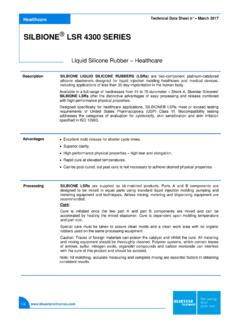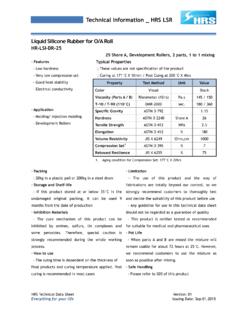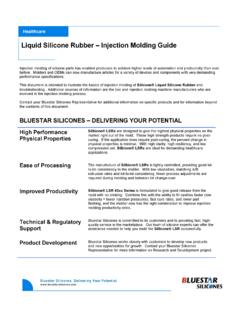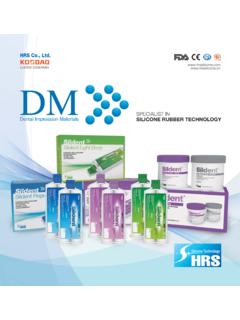Transcription of GXR Static Mixer Product Bulletin - stamixco-usa.com
1 2 Product Bulletin GXR Static Mixer Product Bulletin For Mixing & Dispersing Viscous INTRODUCTIONThe GXR Static Mixer (Licensee of Bayer, AG) is used for mixing and dispersing viscous materials. The Static mixing elements are inserted into a pipe/housing and have no moving parts. They create mixing by directing the viscous materials to follow the geometric structure of the mixing bars within the Static mixing elements that continuously divide and recombine the flow. A very high degree of mixing is achieved in a short length (see Figure #1) with modest pressure drop.
2 Since there are no moving parts, the Static mixing unit requires little maintenance. The unit is also virtually indestructible due to its monolithic construction (see Figure #2). Figure #1: Mixing of blue and white epoxy resins. Empty tube (left) provides no mixing. Eight (8) GXR mixing elements (center and right) create a very high degree of mixing in a short length. Figure #2: The GXR Static mixing elements are extremely strong due to their monolithic cast construction where the mixing bars are joined to each other and to the ring wall via a single molten metal pour (metal mixing element shown above).
3 In plastic construction, they are injection molded with the same monolithic structure. The standard configuration is with eight (8) very efficient Static mixing elements however fewer or more mixing elements are used based on the process requirements for the specific application. The mixing elements are available in metal and plastic construction (see Figure #3). Figure #3: GXR Static Mixer assembly with eight (8) mixing elements in metal construction (left) and in 50% Glass Filled Nylon plastic construction (right) The metal mixing elements are made of high strength 17-4 PH heat treated stainless steel.
4 They are typically used for the Injection Molding and Extrusion of molten plastics, and for the high and low temperature processing of other viscous polymers and resins such as Liquid Silicone Rubber (LSR), Adhesives, Polyurethanes, Polyol, etc. A key operational advantage of the GXR mixing element structure is they may be safely removed from the housing by pressing on the support ring which avoids any force placed on the less robust mixing element grid structure within the ring. This is a major operating advantage over its sister GX Mixer structure (see Figure #4) without a support ring.
5 Figure #4: GX Static Mixer assembly without support ring. The plastic mixing elements are a cost effective alternative when processing most resins at low to medium temperature. They are made of 50% glass-filled polyamide (Nylon) 66 (PA66) resin which provides very high strength. They are also available in a less robust polypropylene plastic construction. The plastic as well as the metal mixing elements have the same monolithic construction and create a high degree of mixing in a short length. 2 MIXING PERFORMANCEThe GXR Static Mixer is used for the mixing and dispersion of viscous fluids.
6 It efficiently mixes liquids of equal and very different viscosities, of equal and very different volumetric flow ratios, and to the degree of homogeneity required by the specific application. Design of a GXR Static mixing unit is based on customer requirements with consideration for flow rate, viscosity, pressure drop, maximum allowable length, and homogeneity required. With the use of Tables #1 and #2, the number of GXR mixing elements required for a specific application may be determined. Table #1: Required Number of GXR Mixing Elements for Mixing In Laminar Flow Conditions Number of GXR Mixing Elements Required Mixing Ratio of Components A : B Viscosity Ratio of Components A : B Pre-Mix Homogeneity Quality (80% Degree of Mixing) CoV = Good Homogeneity Quality (95% Degree of Mixing) CoV = Very Good Homogeneity Quality (99% Degree of Mixing) CoV = 1 : 1 1 : 1 to 100 : 1 8 12 - 14 18 - 20 9 : 1 1 : 1 to 100 : 1 12 18 24 99 : 1 1 : 1 to 100 : 1 18 24 30 Notes.
7 Y CoV = Coefficient of Variation of Mixing (Request documentation if not familiar with terminology) y The number of mixing elements required is approximate and can vary from the given values depending on the viscosity behavior of the materials to be mixed. y The validity of the table is limited to media where under operating conditions the components are soluble in each other in all mixing ratios. If the viscosity ratio of Component A:B is > 100 : 1 (high viscosity bulk stream A: low viscosity additive B), the number of mixing elements required as noted in Table #1 must be increased by the number of mixing elements noted in Table #2 Table #2: Additional GXR Mixing Elements Required based on Viscosity Ratio Viscosity Ratio A : B > 100 300 : 1 > 300 1,000 : 1 > 1,000 3,000 : 1 > 3,000 10,000.
8 1 Additional Number of GXR Mixing Elements Required (In addition to that shown in Table #1) 2 - 3 3 3 - 4 4 To assist in visualizing the data in above Tables #1 and #2, Figures #5 and #6 put in picture form the homogeneity quality achieved. Figure #5: Mixing of Blue and White resins (1:1 volumetric ratio and similar viscosity) is demonstrated where the blue resin is injected into the center of the tubey Row A: In an empty pipe, a slice along the tube length reveals that no mixing occurs when processing viscous materials. y Row B: With eight (8) Type GXR mixing elements, a high degree of mixing is achieved in a short length of L/D=~4.
9 Y Row C: Two sets of eight (8) GXR mixing element assemblies are shown for a total Mixer length of L/D=8. y Row D: Face view of GXR mixing elements shown in Row C. Notice each mixing element is oriented 90o relative to the adjacent. y Row E: The degree of mixing achieved at the outlet of each mixing element shown in Rows C and D is shown in Row E. 3 Figure #6: This photograph is a close-up view of Figure #5, Row E. The blue resin is fed in the center of the pipe to the GXR Static Mixer and is shown at left (INLET TO 1). The remaining photographs show the outlet of each of the 16 GXR mixing elements.
10 KEY DIMENSIONSGXR Mixing Elements are available in Metal Construction (see Table #3) and in Plastic Construction (see Table #4) Figure #7: Dimensions of eight (8) GXR mixing elements. Figure #8: Complete GXR Mixing Element Assembly inside See also Figure #1 - #6 for visualization. a Housing. Housing designs vary dramatically based on customer Needs (see also Figures #9 - #11) Table #3: Metal GXR Mixing Element Key Dimensional Parameters for eight (8) Mixing Elements as shown in Figures #7 & #8. GXR Mixing Elements in Metal Construction 1) Housing Model Number (mm) ) (mm) LME (mm) LTOT 8 Mixing Elements (mm) Bore (mm)





